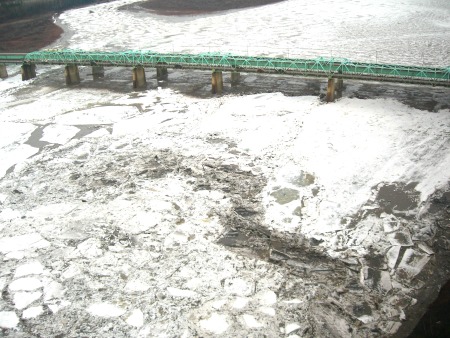
Ice jams that form along rivers are the subject of research by civil and environmental engineering professor Yuntong She.
Edmonton-It's the beginning of summer and Edmonton is experiencing temperatures nearing 30 C to prove it, but two engineering professors are working on research projects rooted in the cold clutches of Old Man Winter.
Mark Loewen and Yuntong She have received funding from the Natural Sciences and Engineering Research Council to support their research into how ice forms on rivers and how we can predict its behaviour. In all, 52 Faculty of Engineering professors were awarded a total of $6.5 million in NSERC Discovery and Discovery Accelerator Grants announced this week by Ed Holder, minister of state for science and technology.
Research conducted by Loewen and She examines different ends of the river ice spectrum. Loewen studies the formation and evolution of frazil ice-the smallest ice crystals that form when river water begins to freeze. She, on the other hand, is trying to understand, model, and predict the behaviour of rivers and ice when ice covering rivers begins to break up, potentially causing floods or damage to homes and public infrastructure.
With a total of $260,000 in funding over five years, Loewen and his graduate students are trying to understand how frazil ice forms and what happens to it after the tiny crystals begin to take shape. They are conducting research in three Alberta rivers: the Peace River in the north, the North Saskatchewan River in central Alberta (the University of Alberta is situated along the banks of the river) and the Kananaskis River in southern Alberta.
By submerging high-definition cameras in the rivers, Loewen and his research team including PhD student Vincent McFarlane capture images of the smallest crystals as they form, just below the surface in supercooled turbulent water. At the smallest end of the scale, the crystals measure a mere 50 microns (0.05mm) in diameter.
"These crystals are disc shaped and they're very sticky," said Loewen. "They stick together and rise to the surface forming these round ice pans you see floating downstream during freeze up. And ultimately, they form a very large percentage of the ice that covers a river."
It's important to understand conditions leading to the formation of ice, especially for hydroelectric dam operators. Loewen is working with B.C. Hydro along the Peace River. Water released by B.C. Hydro dams is too warm to allow ice to form for hundreds of kilometres downstream. But given fluctuating weather conditions and water releases, the zone where ice can begin to form shifts upstream and downstream. Knowing where the ice will form can help the utility manage river ice more responsibly.
Loewen's research is unique.
"This kind of research has never been done before," he said. "There are no published measurements of the size of frazil ice crystals in rivers. It helps us in our understanding of how ice is formed in rivers."
How that ice behaves is the focus of research being conducted by She. Her area of study is a complex combination of thermodynamics, hydrodynamics, and solid mechanics. With NSERC funding of $115,000, She hopes to take on three different projects: one is to create a computer model of the breakup of river ice cover, which will provide important information on how the ice breakup is initiated. A second project will look at the speed of ice runs, which can be slowed down or even stopped at certain river morphological features. This is important because water level can build up even if the ice is stalled only briefly. Both of these projects will help predict where an ice run will stop to form an ice jam, and when it will be released. Her third project will model ice and water flow through multiple channels, such as the Mackenzie River Delta or the Hay River Delta, in the Northwest Territories. Deltas are highly prone to ice jams. The model developed in this project will serve as a practical operational tool for predicting ice jam events, providing information on water level, flow, ice thickness, and velocity.
Ice jam events can happen quickly and She's research could help predict them. In 2007, during a helicopter flight over the Athabasca River in northern Alberta, She followed a wave of water and ice crashing downstream at a speed of about four metres per second[YS1] .
"It was surprising to see, first-hand, how fast the front of ice was moving," said She. "It can happen really fast. Our ultimate goal is to be able to forecast what can be expected-if there will be flooding, and how severe."